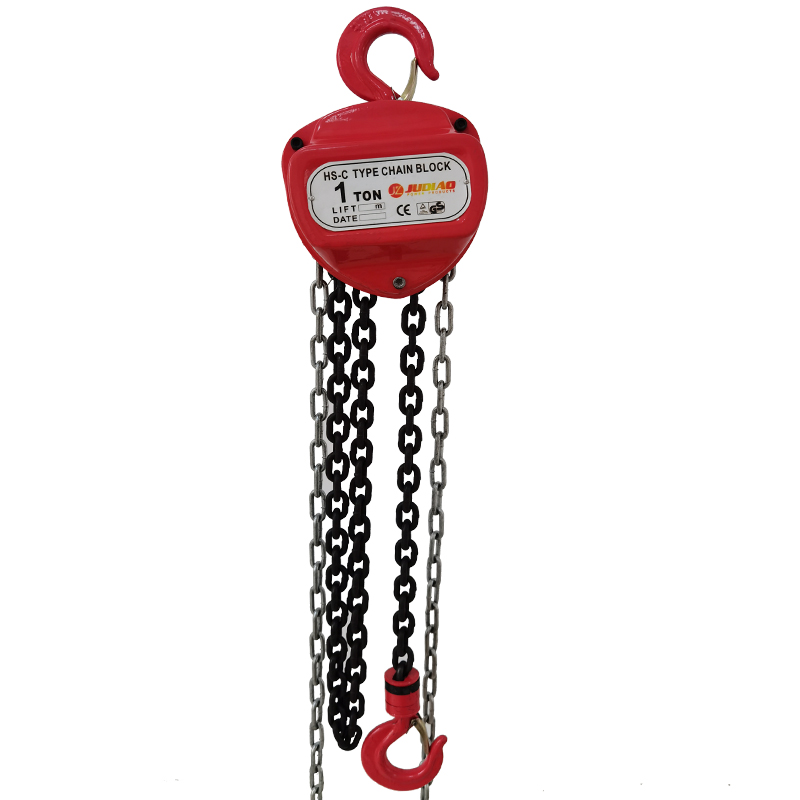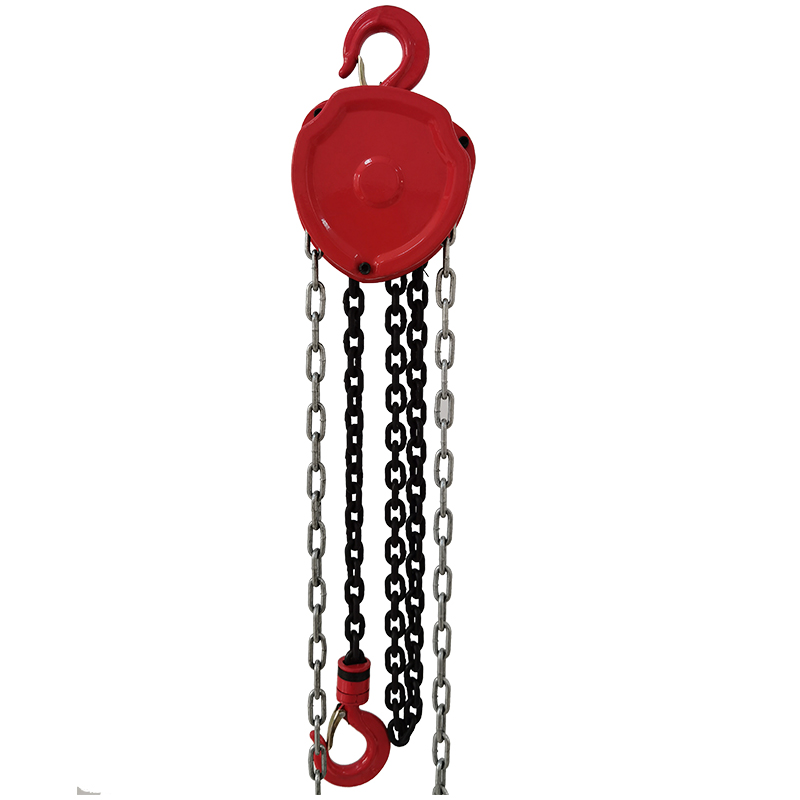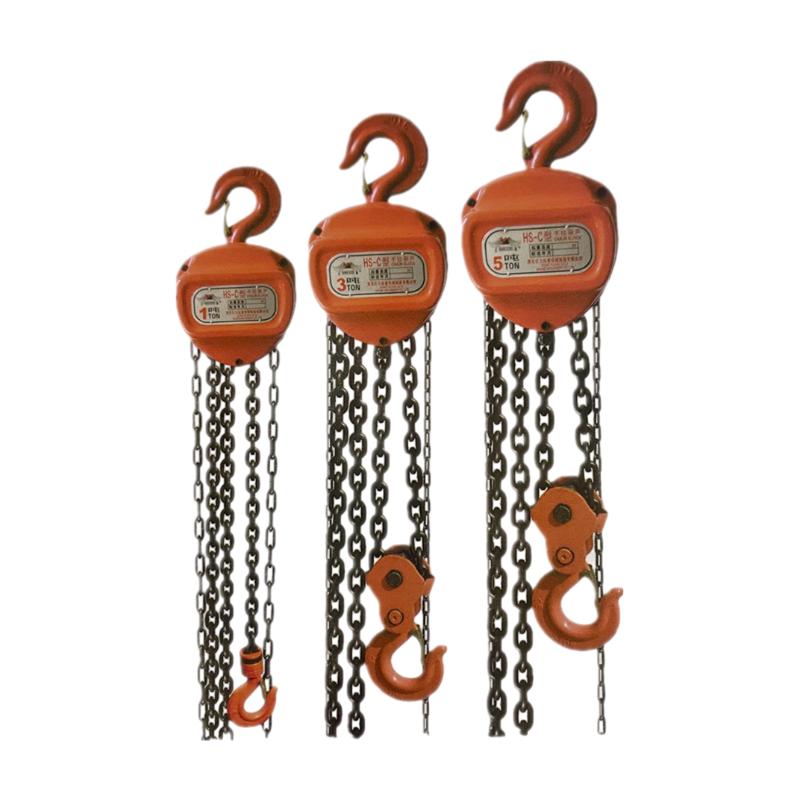


In the vast landscape of industrial operations, the humble yet mighty chain block, also known as a hand chain hoist or manual hoist, stands as a cornerstone of efficient and safe material handling. From small workshops to massive construction sites, these versatile lifting devices provide the mechanical advantage needed to lift heavy loads with minimal manual effort. Their simplicity, reliability, and robust construction make them an irreplaceable tool in scenarios where power sources are unavailable or precise, controlled lifting is paramount. Specifically, the HSC chain block has emerged as a preferred solution, recognized for its superior design and unwavering performance in demanding environments.
This comprehensive guide delves deep into the world of chain blocks, exploring industry trends, technical specifications, application versatility, and the distinct advantages offered by advanced models like the HSC chain block and HS C Type Chain Block. We will uncover the meticulous manufacturing processes, delve into the critical role of quality assurance, and provide insights into selecting the optimal lifting solution for your specific needs, all while adhering to the highest standards of safety and efficiency.
The global market for material handling equipment, including chain blocks, is undergoing significant evolution. Driven by increased industrialization, infrastructure development, and growing emphasis on workplace safety, the demand for reliable and efficient lifting solutions continues to surge. Current trends shaping the chain block market include:
According to a market analysis by Grand View Research, the global material handling equipment market size was valued at USD 240.5 billion in 2022 and is expected to grow at a compound annual growth rate (CAGR) of 6.5% from 2023 to 2030, driven by the expansion of manufacturing and logistics sectors. This robust growth underscores the continuing relevance and innovation within the lifting equipment industry, with the HSC chain block positioned to capitalize on these trends with its reputation for quality and performance.
The efficiency and safety of a chain block are dictated by its technical specifications. Understanding these parameters is crucial for proper selection and operation. Below, we provide a general overview of key parameters for chain blocks, followed by specific data for the HSC chain block.

An HSC chain block demonstrating its capability in a typical industrial lifting scenario.
The HSC chain block, often referenced as the HS C Type Chain Block in some markets, is engineered for superior performance and longevity. Its design incorporates specific features for enhanced safety and operational efficiency.
| Parameter | 0.5 Ton | 1 Ton | 2 Ton | 3 Ton | 5 Ton | 10 Ton | 20 Ton |
|---|---|---|---|---|---|---|---|
| Rated Capacity (Tons) | 0.5 | 1 | 2 | 3 | 5 | 10 | 20 |
| Standard Lifting Height (m) | 3 | 3 | 3 | 3 | 3 | 3 | 3 |
| Load Chain Diameter (mm) | 6 | 6 | 8 | 10 | 10 | 11.2 | 14 |
| Number of Load Chain Falls | 1 | 1 | 1 | 1 | 2 | 2 | 4 |
| Hand Chain Diameter (mm) | 5 | 5 | 5 | 5 | 5 | 5 | 5 |
| Min. Headroom (mm) | 260 | 280 | 320 | 360 | 450 | 650 | 800 |
| Net Weight (kg) | 9 | 12 | 19 | 26 | 38 | 75 | 145 |
| Pulling Force (N) to lift Max. Load | 250 | 290 | 340 | 360 | 390 | 430 | 450 |
These specifications highlight the scalability and robust engineering of the HSC chain block, ensuring it can handle a wide range of lifting tasks safely and efficiently.
The versatility of the chain block makes it indispensable across a multitude of industries. Its ability to provide precise lifting in tight spaces or without external power sources makes it a go-to solution for many critical operations. The HSC chain block, with its robust design, excels in some of the most challenging environments:
The HSC chain block's design, which emphasizes durability and smooth operation, ensures superior performance in these varied and often harsh conditions. Its sealed gears and high-grade materials protect against dust, moisture, and corrosive agents, leading to extended service life and reduced maintenance in critical applications such as in chemical plants or wastewater treatment facilities.
When it comes to manual lifting equipment, not all chain blocks are created equal. The HSC chain block distinguishes itself through a combination of thoughtful design, superior material science, and precision manufacturing, offering several key technical advantages:

A closer look at the robust internal components and gearing of an HSC chain block, engineered for precision and durability.
The manufacturing of a high-quality chain block is a sophisticated process that combines precision engineering, advanced metallurgy, and stringent quality control. Each step is critical to ensuring the final product meets the highest standards of safety, durability, and performance. Here’s a detailed breakdown of the typical manufacturing process, especially for a premium product like the HSC chain block:
(Conceptual Diagram Placeholder: Imagine a flow chart here with arrows connecting steps)
Material Sourcing & Quality Inspection → Forging & Casting → CNC Machining → Heat Treatment → Surface Treatment → Component Assembly → Testing & Quality Control → Packaging & Shipping
(In a real web environment, this would be an SVG or image, potentially with interactive elements or a short video demonstrating key steps.)
The foundation of a durable chain block lies in the quality of its raw materials. For the HSC chain block, this involves sourcing high-grade alloy steels (e.g., AISI 8620, 42CrMo) for critical components like load chains, gears, and hooks. Incoming materials undergo rigorous inspection, including spectroscopic analysis for chemical composition, ultrasonic testing for internal flaws, and hardness tests to ensure they meet specified mechanical properties. This strict adherence to material standards is crucial for achieving the required breaking strength and wear resistance, often exceeding typical industry benchmarks like ASME B30.16.
Key structural components, such as hooks and load chain links, are often manufactured through hot forging. This process involves shaping metal under extreme pressure and heat, aligning its grain structure for maximum strength and fatigue resistance. The housing and other less stressed components might be made through precision casting, followed by careful fettling and grinding to remove any imperfections. Forged components are inherently stronger and more reliable than cast equivalents for load-bearing applications, a key differentiator for premium chain blocks.
Precision is paramount for the internal mechanisms. Gears, shafts, and bearing seats are manufactured using advanced Computer Numerical Control (CNC) machining. This ensures extremely tight tolerances, smooth surfaces, and perfect alignment, which are critical for the chain block's efficiency, low operating effort, and extended lifespan. Accurate machining minimizes friction and wear, directly contributing to the HSC chain block's renowned smooth operation.
After machining, many components (especially gears, shafts, and load chain) undergo specific heat treatment processes such as carburizing, quenching, and tempering. This process alters the microstructure of the steel, significantly increasing its hardness, wear resistance, and overall strength. For example, the load chain of an HSC chain block is often case-hardened to achieve a hard surface for wear resistance while retaining a tough, ductile core to absorb shock loads without brittle fracture. This is a critical step that enhances the chain block's longevity and safety under repetitive stress.
To protect against corrosion, especially in harsh industrial or outdoor environments, external components and sometimes even internal parts receive specialized surface treatments. This can include durable powder coating, electro-galvanization, or hot-dip galvanization. These coatings provide a protective barrier against rust, chemicals, and abrasion, significantly extending the chain block's operational life in applicable industries like marine, chemical, and wastewater treatment, where anti-corrosion properties are essential.
Skilled technicians meticulously assemble the hundreds of components that make up a chain block. This stage involves precise alignment of gears, shafts, bearings, and the braking system. Proper lubrication with high-performance grease is applied to all moving parts to ensure smooth operation and minimize wear from the outset. Each HSC chain block is assembled with attention to detail, ensuring all parts fit perfectly and function as intended.
This is arguably the most critical stage. Every single HSC chain block undergoes a series of rigorous tests to ensure it meets and exceeds international standards like ISO 9001 (Quality Management), ANSI B30.16 (Overhead Hoists), and CE directives. These tests typically include:
Only chain blocks that pass all these stringent tests are cleared for packaging, guaranteeing their reliability and safety in the field. Our HSC chain block models are routinely certified by third-party inspection agencies to further bolster confidence.

Rigorous quality control and testing processes ensure every HSC chain block meets the highest safety and performance standards before leaving the factory.
Selecting a chain block isn't just about the product; it's about partnering with a manufacturer who embodies quality, reliability, and excellent customer support. While we don't name competitors, we can outline what distinguishes a premium manufacturer (like QYJULI) from others in the market, focusing on aspects that directly benefit the end-user.
| Feature/Aspect | Premium Manufacturer (e.g., QYJULI) | Standard/Budget Manufacturer |
|---|---|---|
| Material Quality | High-grade alloy steels (G80/G100), heat-treated, certified origin. Forged components. | Lower-grade carbon steel, potentially inconsistent material composition. Cast components. |
| Manufacturing Process | Precision CNC machining, advanced heat treatments, strict process control. | Basic machining, less consistent heat treatment, manual assembly with less precision. |
| Safety Features | Double pawl brake, integrated overload protection (optional/standard), robust safety latches, compliance beyond minimum. | Single pawl brake, no overload protection, weaker latches, basic compliance. |
| Testing & Certifications | Individual proof load testing, comprehensive QC, ISO 9001, CE, ANSI B30.16 certified. | Batch testing only, basic QC, minimal or questionable certifications. |
| Durability & Lifespan | Designed for extended service life, low wear, minimal maintenance needs. Often 10+ years with proper care. | Shorter lifespan, higher wear rate, frequent maintenance/replacements needed. |
| Operational Efficiency | Low hand chain effort, smooth operation due to precision gears and bearings. | Higher hand chain effort, rougher operation, more friction. |
| Warranty & Support | Comprehensive warranty (e.g., 2-5 years), readily available spare parts, expert technical support. | Limited or no warranty, difficult to find spare parts, minimal support. |
| Customization Options | Wide range of capacities, lifting heights, special coatings, specific hook types. | Very limited standard options only. |
Choosing a manufacturer like QYJULI, with a proven track record of over two decades in the lifting industry, means investing in a chain block that offers superior safety, unmatched reliability, and a lower total cost of ownership in the long run. Our commitment to quality, as demonstrated by our comprehensive manufacturing process for the HSC chain block, ensures peace of mind for our clients.
While standard chain block models meet many general lifting requirements, specialized applications often demand tailored solutions. A reputable manufacturer understands this and offers customization options to ensure optimal performance and safety for unique operational challenges. For the HSC chain block, customization possibilities include:
Our team of engineers works closely with clients to understand their unique operational parameters, ensuring that the customized HSC chain block perfectly aligns with their safety protocols and efficiency goals.
The true measure of a chain block's quality is its performance in real-world applications. Here are a few illustrative examples of how the HSC chain block has delivered exceptional results for our clients:
A large-scale open-pit mining operation in Western Australia required a robust and portable lifting solution for routine maintenance of heavy machinery in remote areas, often without access to electricity. They opted for multiple HSC chain blocks ranging from 5-ton to 10-ton capacities. The inherent durability and corrosion resistance of the HSC chain block proved invaluable in the harsh, dusty, and sometimes wet mining environment. The ease of operation and precise load control significantly reduced downtime for repairs, leading to a 15% increase in equipment availability within the first six months of deployment. The positive customer feedback consistently highlighted the low maintenance requirements and the reliable braking system, even under continuous heavy use.
A specialized chemical processing plant needed to install delicate, heavy valves in a highly corrosive environment where sparks from electric hoists were a safety concern. They chose a customized, corrosion-resistant 2-ton HSC chain block with enhanced surface treatments. The precision gearing allowed for extremely fine adjustments during valve positioning, preventing costly damage. The chain block's inherent safety (no sparks) and its ability to withstand exposure to corrosive fumes ensured a safe and successful installation. Our client reported that the HSC chain block has performed flawlessly for over three years in this challenging environment, requiring only minimal routine inspections.
A prominent shipyard in Southeast Asia faced challenges in quickly moving and positioning heavy ship components in confined spaces during repair operations. They integrated 3-ton and 5-ton HSC chain blocks into their rigging setups. The compact design and high mechanical efficiency enabled their teams to maneuver heavy parts with greater ease and safety. The robust construction proved resilient against the typical wear and tear of a bustling shipyard, including exposure to saltwater mist. Their project managers noted a significant improvement in efficiency and worker safety, attributing it to the dependable performance and ease of use of the HSC chain block.
At QYJULI, we don't just sell chain blocks; we embody a deep understanding of lifting mechanics and safety. Our approach to content and product development is rooted in the Google framework:
The lifespan of an HSC chain block depends heavily on usage frequency, load conditions, and maintenance. With proper maintenance, adherence to operating limits, and in normal working environments, an HSC chain block can reliably last for 10-15 years or even longer. Our robust construction and high-grade materials are designed for exceptional durability.
The HSC chain block is constructed from premium materials. The load chain is typically made from hardened G80 or G100 alloy steel for maximum strength. Hooks are drop-forged and heat-treated alloy steel. The housing is typically robust steel or high-strength cast iron, and internal gears are precision-machined and heat-treated for wear resistance.
The double pawl braking system provides a redundant safety mechanism. If one pawl (a locking mechanism) were to fail, the second pawl would immediately engage to hold the load. This design significantly reduces the risk of load slippage, providing superior load control and enhanced safety compared to single pawl systems.
Our HSC chain blocks are manufactured to meet or exceed international safety standards, including CE (Conformité Européenne), GS (Geprüfte Sicherheit - German Tested Safety), ANSI B30.16 (American National Standards Institute for Overhead Hoists), and AS 1418.2 (Australian Standard for Cranes, Hoists and Winches). We also operate under an ISO 9001 certified quality management system.
Yes, the HSC chain block can be adapted for such environments. We offer models with specialized anti-corrosion treatments (e.g., galvanization, marine-grade coatings) for use in humid, saline, or chemical-prone areas (like petrochemical plants, marine applications, or wastewater treatment). For hazardous areas requiring explosion-proof equipment, specific ATEX-certified versions can also be provided.
Regular maintenance is crucial for safety and longevity. It is recommended to perform a visual inspection before each use. A more thorough inspection by a qualified person should be conducted at least annually, or more frequently (e.g., quarterly) for heavy-use applications. This includes checking the chain for wear, deformation, or corrosion, inspecting hooks and safety latches, testing the brake, and ensuring proper lubrication of moving parts. Consult the product manual for specific guidelines.
Always select a chain block with a Working Load Limit (WLL) that is equal to or greater than the heaviest load you intend to lift. Never exceed the rated capacity. It is generally recommended to choose a chain block with a slightly higher capacity than your maximum anticipated load to provide a safety margin and reduce wear on the equipment. Consider factors like the frequency of use and the criticality of the lift.
For more detailed technical support or specific inquiries, please visit our product page: HSC chain block.
Experience the unparalleled safety, durability, and efficiency that defines our HSC chain block. Built to withstand the toughest industrial demands, it's the smart investment for reliable lifting.
Explore the HSC Chain Block Now


